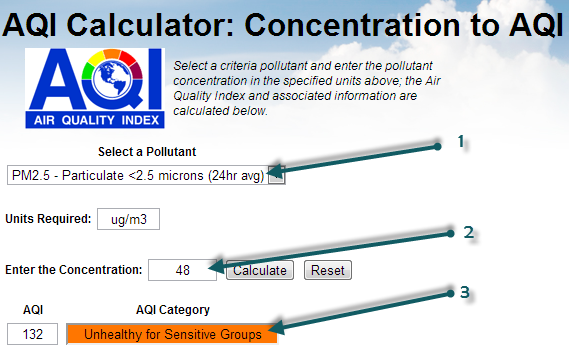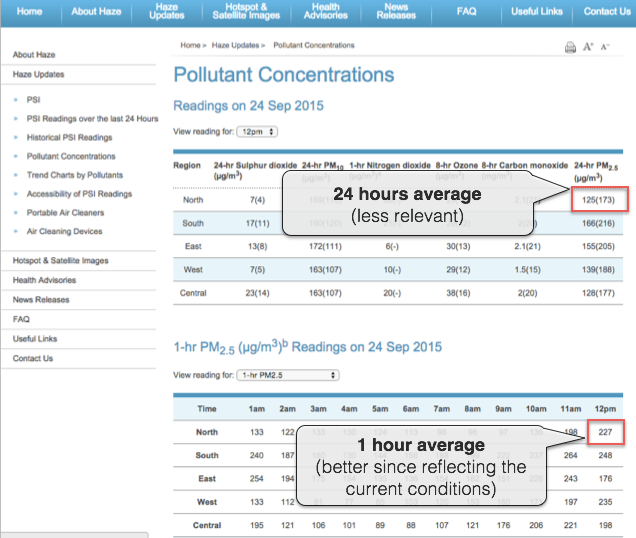In April 2014, the Singapore NEA has updated the PSI calculation to also include PM2.5. http://www.nea.gov.sg/anti-pollution-radiation-protection/air-pollution-control/psi
With the recent Southeast Asia Smog from Indonesia affecting Singapore and now Malaysia, we got many questions about why there is a difference between the data which can be read from Singapore NEA website (nea.gov.sg) and the World Air Quality Index project Singapore webpage.
たとえば、現在 NEA の Web サイトで読める内容は次のとおりです。

歴史的な理由から、シンガポールは大気質の評価にPSI (汚染物質基準指数) を使用しています。上の画像では、番号 1 は PSI 評価に使用される PM10 値に対応します。値67(/59) 、PSI 59 に相当する 67 μg/m3 と読み取れます。PSI は、各汚染物質 (PM 10 、SO 2 、NO 2 、O) の個別の PSI の最大値として評価されます。 3 (オゾン) と CO 2 。
PSI(Singapore-North) = max( PSIPM10-based, ... PSIO3-based )= max (59, ..., 77) = 77
そうは言っても、興味深いのは、この同じ表の最後の列に PM2.5 データも提供されていることです (3 を参照)。このデータは μg/m3 のみで提供され (2 を参照)、PSI のようなものへの変換 (つまり、PM2.5 質量から汚染指数または品質指数への変換) はありません。ただし、この変換は存在しており、米国環境保護庁によって定義されています。変換を行う最も簡単な方法は、 airnow.govで入手可能なオンライン計算機を使用することです。

If you select the PM2.5 (1), then enter the mass concentration of 48 (2), can click on Calculate, you will obtain the AQI of 132 (3). So, based on the PM2.5 AQI conversion, the PSI that is used for Singapore could be extended (let's call it PSI++) to also take into account the PM2.5 information. In which case, the PSI++ would be the maximum of the regular PSI (based on PM10 only) and the PM2.5 AQI:
PSI++ = max( PSI, AQIPM.25 ) = max( 77, 132 ) = 132
This PSI++, that is commonly referred as AQI (or Air Quality Index), is what is being used on the the World Air Quality Index project, for all the cities (provided PM2.5 is available for the city). And this explains why the values are different between the NEA website and the World Air Quality Index project.
Moreover, when doing the convertion, make sure you use the 1-hour reading for the PM2.5 concentration rather than the 24-hours averaged value, as shown on the below image:

http://www.haze.gov.sg/haze-updates/pollutant-concentrations/type/PM25-1Hr
If you want to know more about PM10 vs PM2.5, and especially why PM10 is still used, please check the faq entry about why is PM2.5 often higher than PM10? Is PM10 still a relevant measure?
--
For more information about specific countries or continent, please refer to those articles: Thailand and Malysia - India - China - Hong Kong / Canada (Air Quality Health Index) - South America - Australia - Quebec and Montreal - Singapore - Poland - Indonesia .
For information about the 24 hours averaging used or Ozone and Particulate Matter (PM2.5), please refer to those two articles: Ground Ozone Index - PM2.5 Instant Cast
